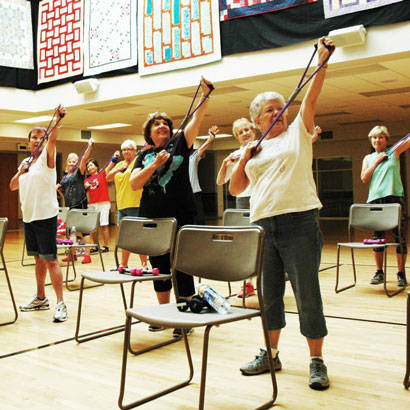
Each May, we observe Older Americans Month, a celebration led by the Administration for Community Living (ACL), U.S. Department of Health and Human Services. This year’s theme, “Age Out Loud,” seeks to amplify the voices of older adults on issues, such as arthritis and fall injuries, that prevent them from living full, healthy lives and maintaining their independence. With the number of older Americans expected to increase from 46 million in 2014 to 98 million by 2060, it is imperative that we engage older adults in our communities and empower them to be healthy and independent.
Arthritis, a chronic disease characterized by joint pain, swelling and stiffness, affects one in four (53 million) adults. The risk of developing arthritis increases with age: nearly half of Americans 65 and older suffer from the disease. Impaired joint function in the hands, wrists, knees, hips or parts of the spine can significantly limit an older adult’s mobility, balance and ability to perform daily tasks. Decreased physical activity increases the risk of other chronic diseases, including heart disease and diabetes. Studies show that older adults with arthritis also experience 30 percent more falls than adults without arthritis and are more prone to injuries. Adults with arthritis can reduce their symptoms, prevent falls and improve overall health by participating in evidence-based health promotion programs, such as physical activity, chronic disease self-management and fall-prevention programs.
Physical activity programs, such as Walk With Ease, Fit & Strong!, EnhanceFitness and Tai Chi for Arthritis, are designed to help older adults manage and reduce symptoms of arthritis. Engaging in these physical activity programs can help older adults protect their joints, improve their muscle strength, endurance and balance, and reduce their risk of falling.
Another program that has helped people with chronic conditions, like arthritis, manage their health and improve their quality of life is the Chronic Disease Self-Management Program (CDSMP). CDSMP participants gain the confidence and skills they need to take control of symptoms like pain and fatigue, manage their medications and effectively communicate with their healthcare providers.
Local park and recreation departments are uniquely positioned to offer these health promotion programs for older adults who live in their communities. For the past four years, more than across 46 states and American territories have successfully engaged almost 6,000 older adults in physical activity programs.
“Our participants bond together as a group to support and encourage each other,” says Cheryl Fischer, a Walk With Ease instructor at Arizona’s City of Mesa Parks, Recreation and Community facilities. “I’ve seen the success of the Walk With Ease program by taking a person with arthritis, or an inactive person, from an entry level of exercise to a more functional level of exercise through walking. The participant book was well written and provided a lot of information and guidance,” she adds.
Cindy Allen, a Walk With Ease instructor at Shelbyville Parks in Shelbyville, Tennessee, noted one of their Walk With Ease program participants could only walk two laps with her walker on the first day, but by the end of the six-week session was able to walk over a mile in 30 minutes.
Many resources are available to offer these programs to older adults in your community. Below is some information about a few resources to help get you started:
Select a program that best fits the goals of your organization and the needs of your community: This chart of evidence-based, health-promotion programs provides information about program goals, training requirements, costs and more.
Develop a step-by-step plan to successfully implement a program: These resources offer a step-by-step approach to help with each part of the process, from planning to outreach and sustainability.
Partner with state and local organizations: The Administration for Community Living has funded state agencies and community organizations to implement evidence-based CDSME and falls prevention programs. Connect with a CDSME or falls prevention grantee in your state to attend a local program leader training, learn best program practices, and recruit older adult participants.
Partner with state and local falls prevention coalitions : Falls prevention coalition members have a common goal of reducing older adult falls, fall-related injuries and deaths in their communities or states. Members educate older adults about strategies to prevent falls and connect them with community falls prevention programs.
View and share resources from the National CDSME Resource Center and the National Falls Prevention Resource Center to educate older adults about how they can manage chronic conditions, like arthritis, and prevent falls.
Join us in celebrating Older Americans Month, and make the commitment to empower older adults through evidence-based programming for improved health and quality of life.
Chelsea Gilchrist is a Program Associate at the National Falls Prevention Resource Center. Lesha Spencer-Brown is NRPA’s Health & Wellness Program Manager.

